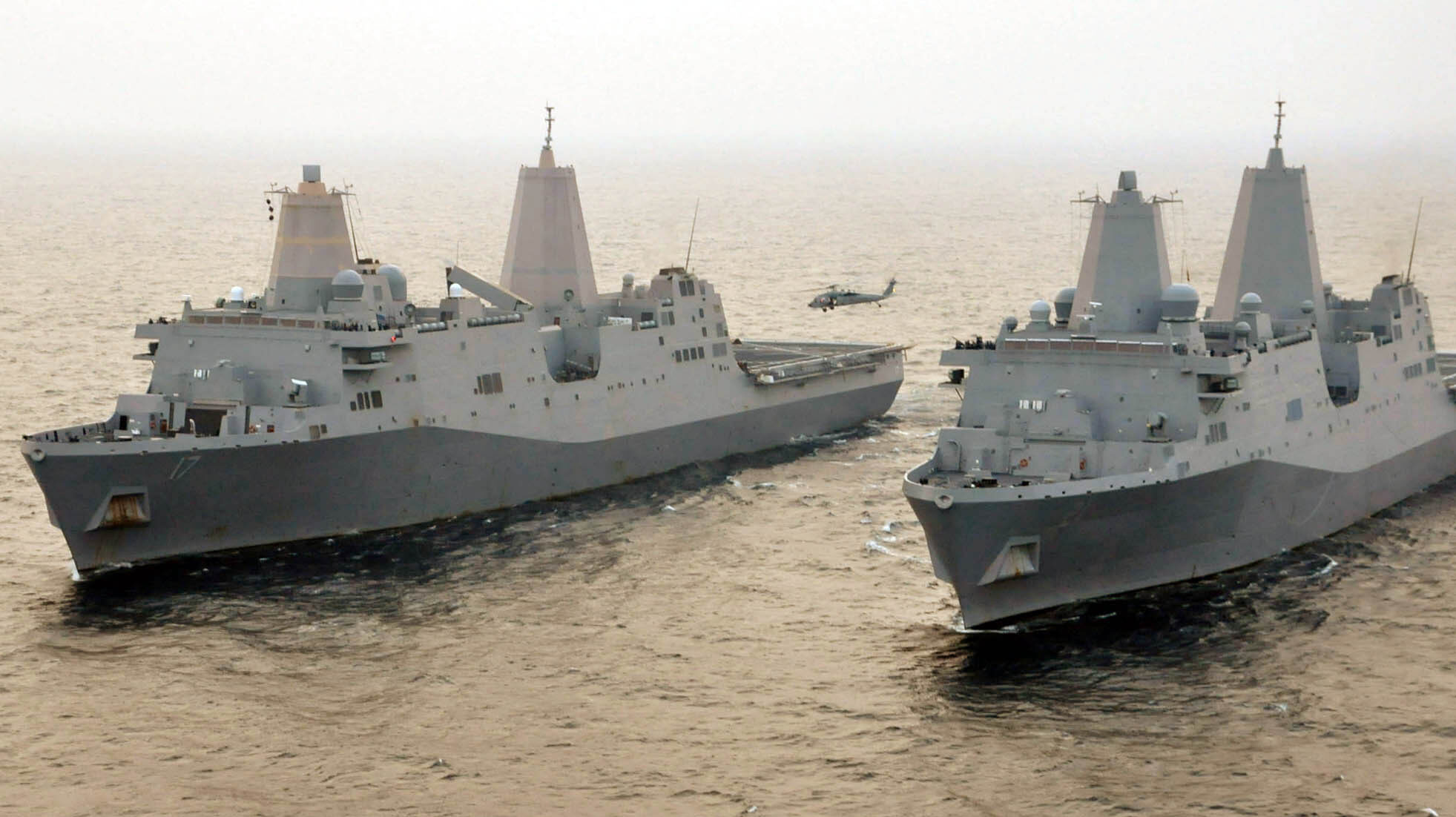
The amphibious transport dock ships USS San Antonio and USS New York are underway together in the Atlantic Ocean off the coast of Virginia. San Antonio is conducting ship handling drills with New York during San Antonio’s second phase of sea trials, which are primarily focused on combat systems testing and developing crew proficiency. (U.S. Navy photo by Petty Officer 1st Class Edwin F. Bryan)
WASHINGTON — Lawmakers in this year’s defense policy bill had a specific, albeit mostly implied, message to send the Navy about its fleet of amphibious ships: Make sure you’re ready to buy more next year.
That wouldn’t be noteworthy in most years; the amphibious shipbuilding contingent in Congress is lively and vocal. But what makes this year different is the elephant in the Navy’s fiscal 2023 budget request: The service projected it would stop buying San Antonio-class transport dock ships starting next year, ending production eight ships short of previous plans.
Because of how the federal budgeting and spending process works, Congress can’t demand the Navy continue to buy amphibious ships, so it may not be surprising there is no explicit language in the bill addressing the projected production sundown. But what lawmakers can do is write policy that pushes the service in a specific direction, and on that front, there was no shortage of activity.
“Congress is sending the Navy a clear message that it wants construction of large amphibious ships to continue. It set a target of 31 ships, which is about where the fleet is now and would require continuing production of the San Antonio class,” said Mark Cancian, a military analyst with the Center for Strategic and International Studies.
The target Cancian referred to is a new minimum ship count established in this year’s defense policy bill, requiring the Navy and Marine Corps maintain a fleet of 31 amphibious vessels. Historically, such legislation is more symbolic than anything else because it lacks meaningful penalties if the service fails to reach the goal — but it does set a clear marker from lawmakers about where they stand.
Both Capitol Hill and the Pentagon became fixated on the idea of a 355-ship fleet during the Trump administration, and lawmakers even passed legislation mandating the service maintain such a fleet. But to date the service’s fleet is roughly 290 ships strong, and it’s not clear that any one individual at the Pentagon would be held to account if that number doesn’t reach 355 soon.
One of the lawmakers who championed the provision requiring 31 amphibious ships is Rep. Rob Wittman, R-Va, whose opinion on shipbuilding holds weight in his caucus following years of him being the senior Republican on the House Armed Services seapower and projection forces subcommittee. (Wittman recently disclosed he would step down from that position and pursue the senior spot on the tactical air and land subcommittee.)
“With the inclusion of a 31 amphibious ship floor, support for San Antonio and America-class amphibs, support for light amphibious warship, and affirming the [Marine Corps] Commandant’s role as an amphibious force assessor, Congress is unambiguous about our intent to keep forcible entry as a core capability of the U.S. Marine Corps,” he told Breaking Defense on Tuesday. “We need to ensure that we don’t lose cadence on our hyper efficient amphibious ship construction line.”
Marine Guidance
Wittman’s reference to the Marine Corps commandant’s role alludes to another legislative provision included in this year’s bill, enshrining in law that the most senior Marine should have an explicit role in defining the Pentagon’s requirement for amphibious ships.
That, in the words of the current commandant, is a “very positive thing.”
“Congress understands that that’s a service requirement. So, [they] want to hear from the service what you need,” Gen. David Berger said at a Defense Writers Group event last week.
Yet another sign that lawmakers have no intention of slowing down the amphib buys is the fact they authorized additional advanced procurement funding, a step that would be unnecessary if the production line were to shut down next year. (The actual funding for those future vessels must come from the appropriators, but nonetheless, the authorization for the funding reflects lawmakers’ state of mind on the issue.)
Another key lawmaker for the amphib community is Sen. Roger Wicker, R-Miss., whose stances on issues like Navy force structure will take on more weight next Congress when he is expected to become the senior Republican on the Senate Armed Services Committee.
“Amphibious warships are an essential component to our force structure, and that will not change for the foreseeable future,” Wicker told Breaking Defense in a statement Tuesday. “This year’s NDAA reflects Congress’s view that the Navy and Department of Defense will need additional resources to ramp up production sooner rather than later as we work to deter China.”






















